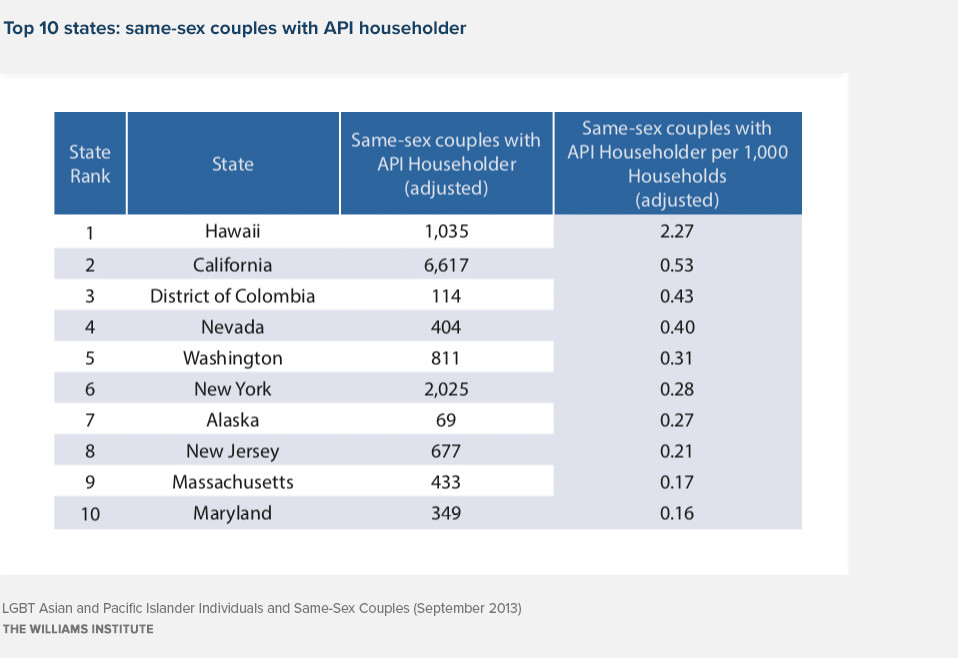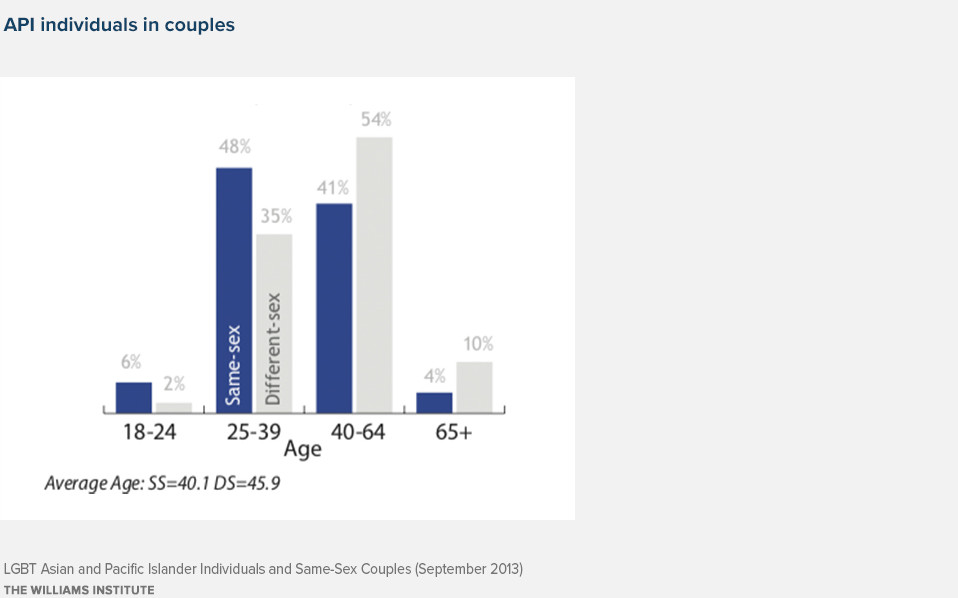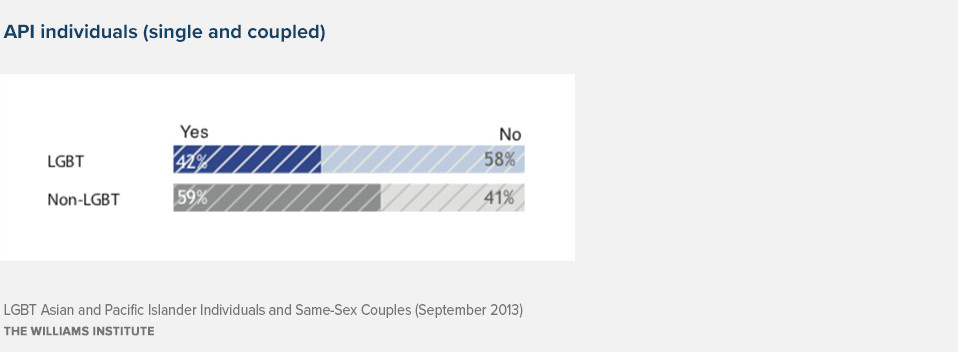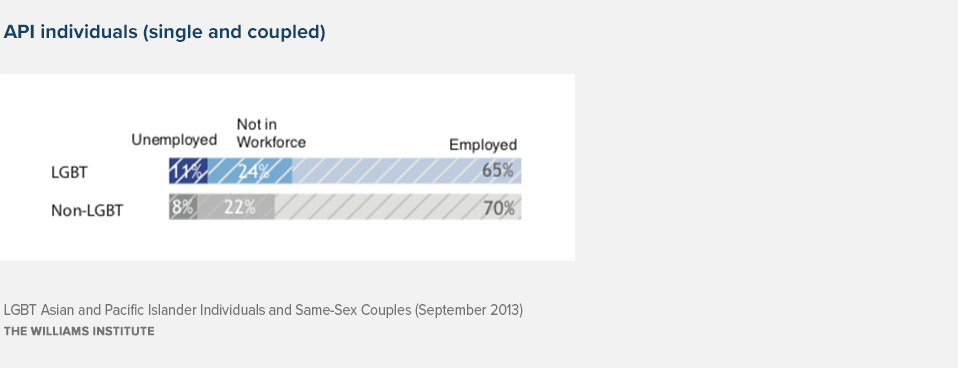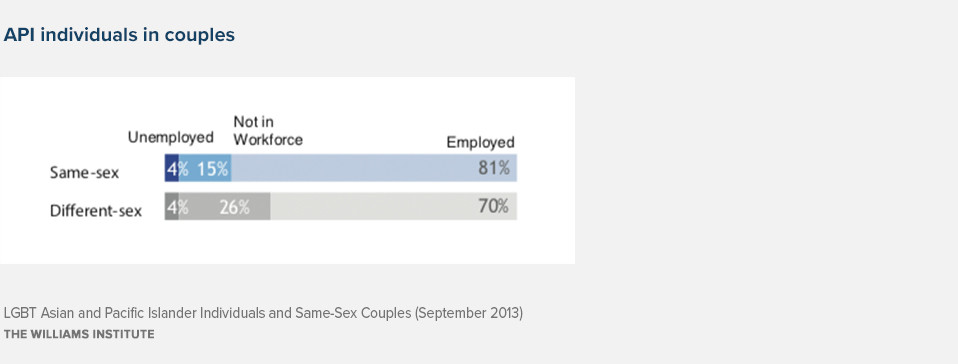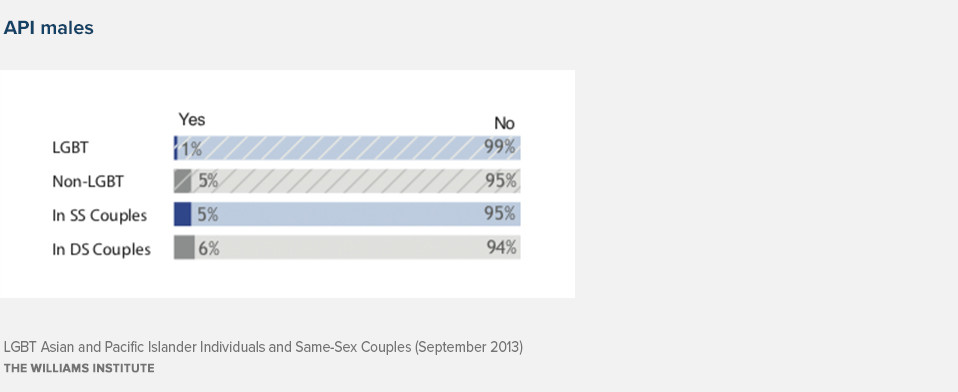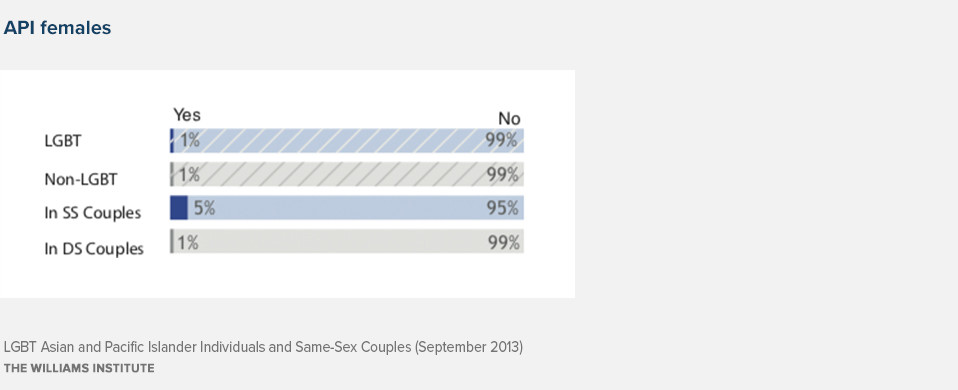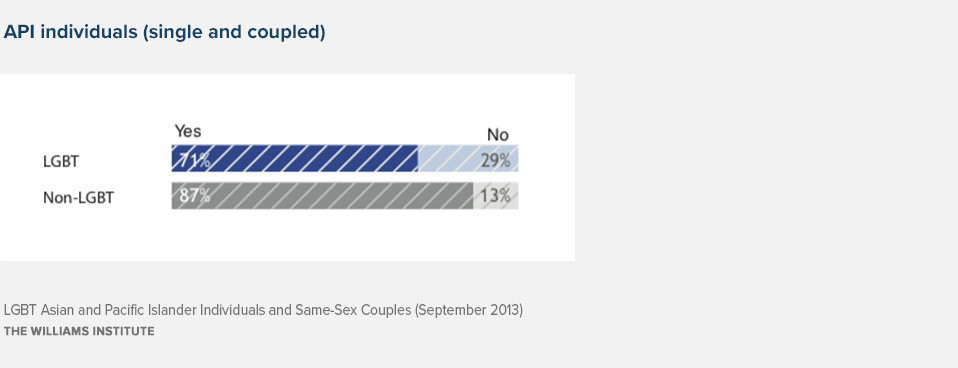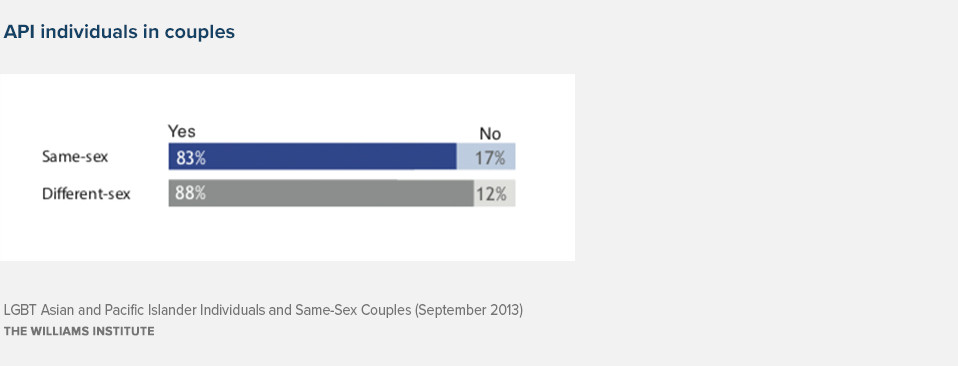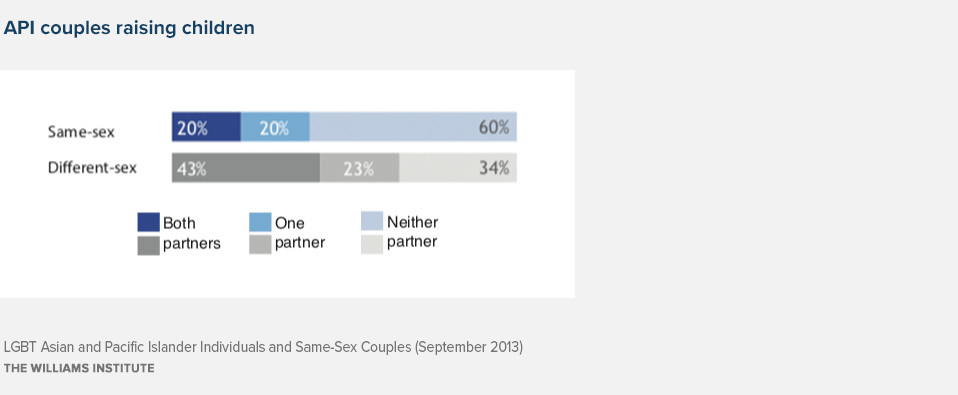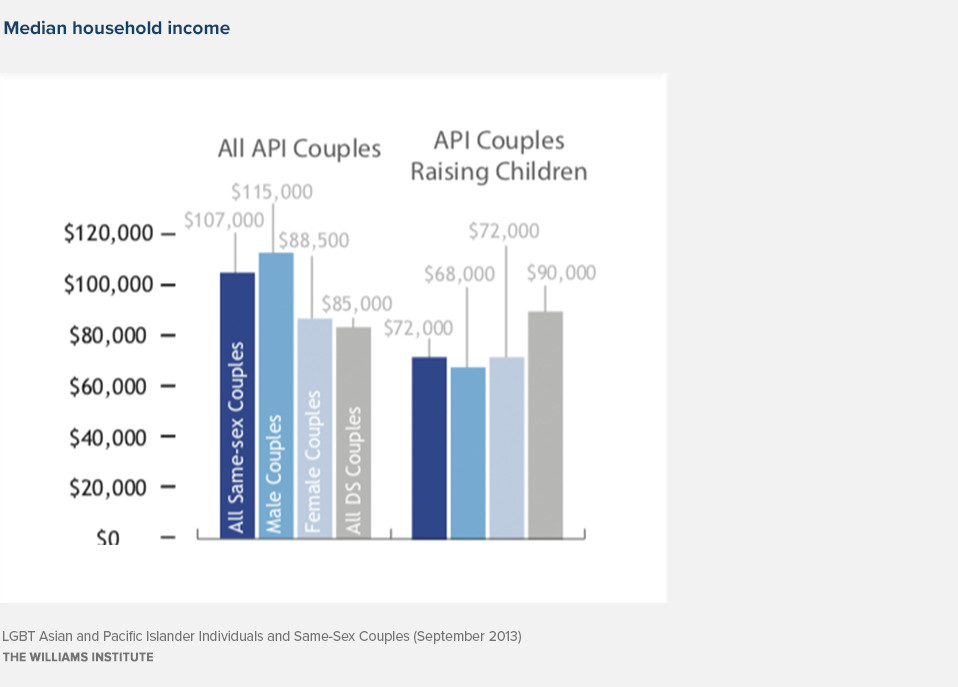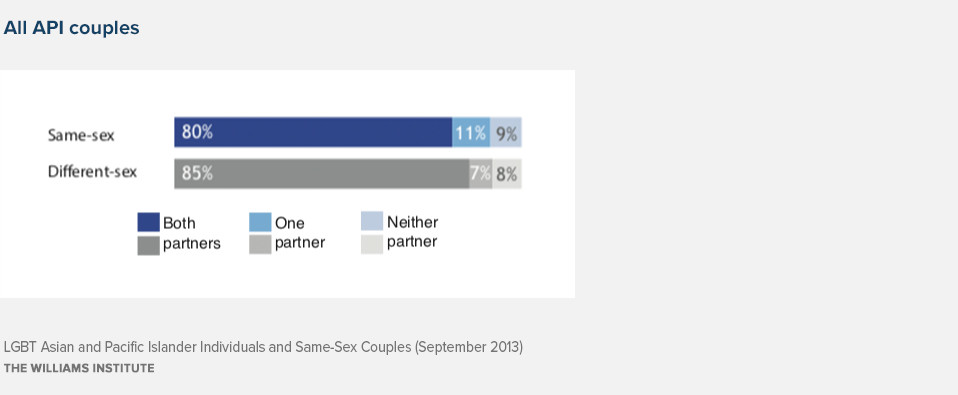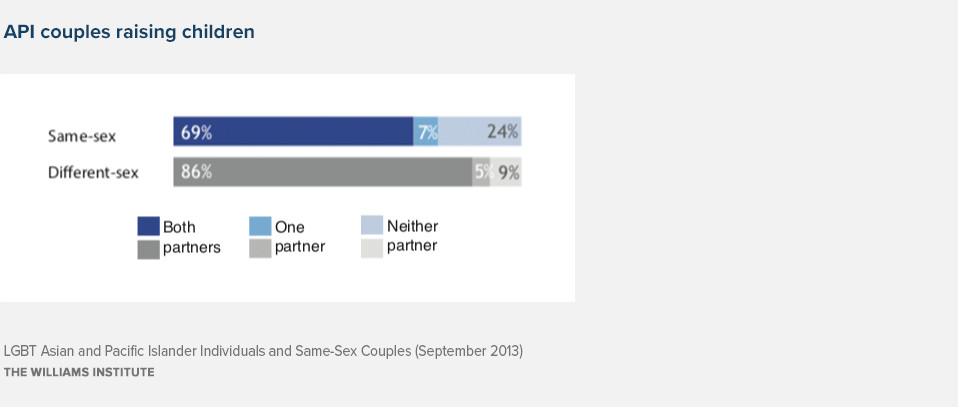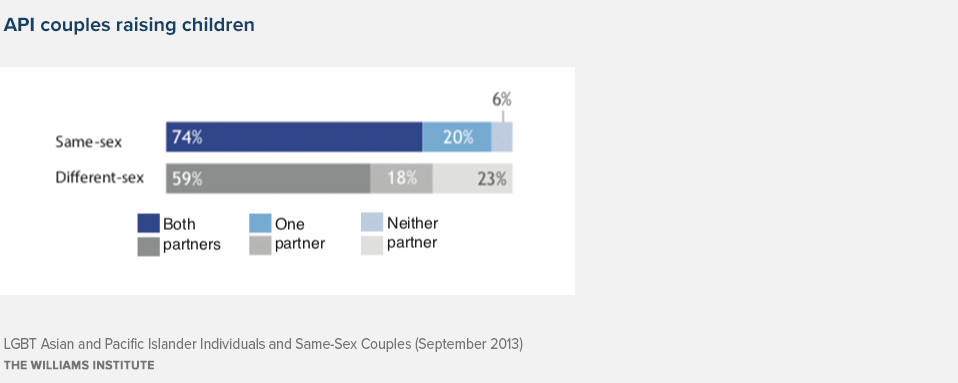Overview
This report uses the best available data to provide a population estimate of LGBT Asian-Pacific Islander (API) individuals and API same-sex (SS) couples in the United States, along with a general overview of their socioeconomic and demographic characteristics.
Geographic Distribution
LGBT API adults tend to live in areas where there are higher proportions of API individuals, as opposed to areas with higher proportions of the broader LGBT population. About 1/3 of API same-sex couples live in California, Hawaii, and New York. The county-level maps use U.S. Census 2010 data measuring same-sex couples. The Census data describe both different-sex (DS) and same-sex (SS) couples by the race or ethnicity of the “householder,” who was Person 1 on the Census form. Person 1 is usually the person in whose name the home is either owned or rented. Appendix A contains a detailed description of who is included in each section of this snapshot report, along with additional information on how to understand the map key.
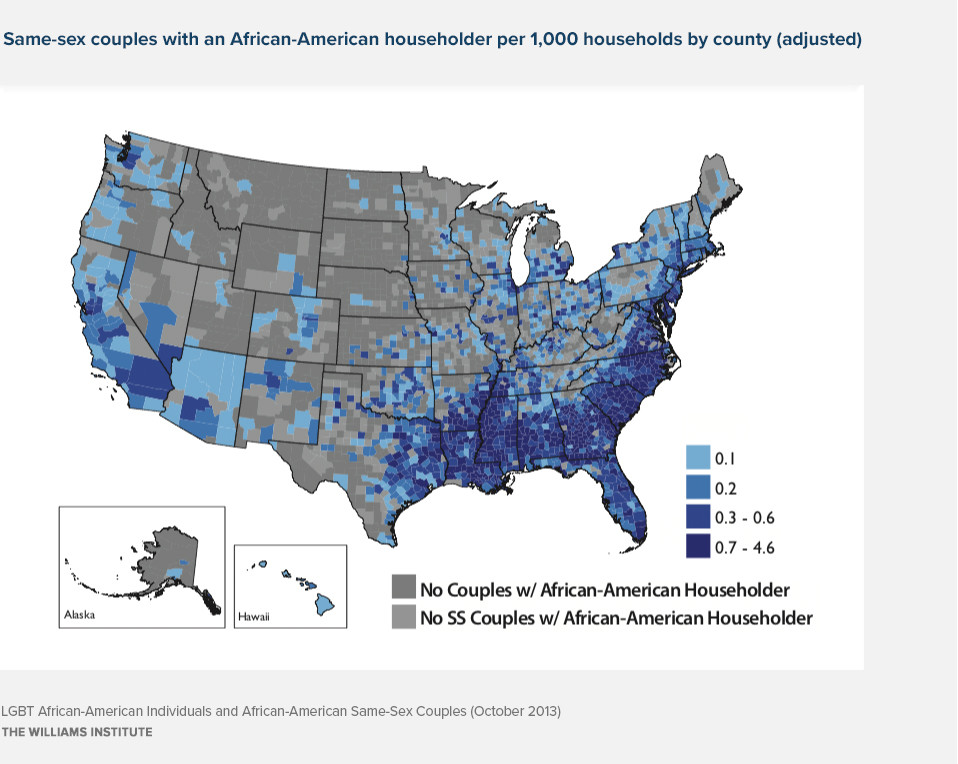
Source: U.S. Census 2010 data (adjusted)
Key Findings
- Overall, API individuals in same-sex couples are faring better than their different-sex counterparts. However, specific subpopulations show signs of socioeconomic vulnerability, such as female API same-sex couples, couples raising children, and Pacific Islander and Native Hawaiian individuals in same-sex couples.
- 25.9% of all API same-sex couples are raising children. API same-sex couples raising children are less likely to include two college graduates than comparable API different-sex couples (20% vs. 42%).
- LGBT API adults have higher rates of unemployment than non-LGBT API adults (11% vs. 8%).
- 42% of LGBT API adults have completed a college degree or more, compared to 59% of non-LGBT API adults. Notably, rates of educational attainment vary among subpopulations within the API community.
- API male same-sex couples out-earn API female same-sex couples by more than $25,000. However, female API same-sex couples report a similar average household income when compared to API different-sex couples.
- API individuals in same-sex couples are more likely to be a U.S. citizen than their counterparts in different-sex couples (81% vs. 68%). Binational couples make up 1 of every 5 API same-sex couples. Furthermore, 1 in 4 API same-sex couples raising children have at least one partner who is not a citizen.
- API individuals in same-sex couples are more likely to be born in the U.S. than API individuals in different-sex couples (35% vs. 13%). The top three countries of origin reported for API individuals in same-sex couples born outside the U.S. are the Philippines, Vietnam and Taiwan.
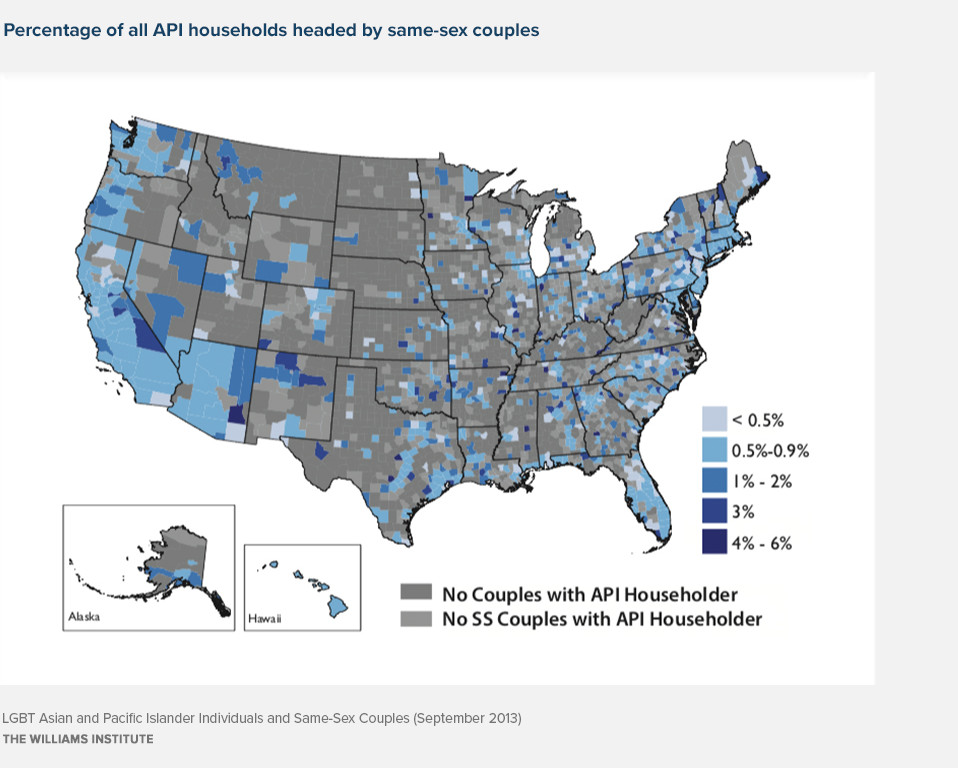
Source: U.S. Census 2010 data (adjusted)
Among API Households
Nationally, 1 in about 240 API households are led by a same-sex couple (0.4%). Counties, where there is a higher proportion of API same-sex couples than the national average, tend to be in areas where there are fewer API households overall, meaning the same-sex households make up a large part of the API population in those areas. These counties can be found in the South and Midwest regions of the country. Notably, large portions of the Midwest report very few API households in general.

* “Own” children are never-married children under 18 who are sons or daughters of one partner or spouse (Person 1) by birth, marriage (stepchild), or adoption.
Source: U.S. Census 2010 data (adjusted)
Couples Raising Children
Although 25.9% of same-sex couples with a API householder are raising children, these couples are not concentrated in major metropolitan areas. The map on the left indicates that API same-sex couples raising children are scattered throughout counties where API households are found.
Geography
API adults in same-sex couples tend to live in areas where there are higher proportions of API individuals, as opposed to areas with higher proportions of the broader LGBT population. This is evident by the inclusion of several Western States in the top ten list which tend to be areas known for API residency, but not LGBT residency. Several states on the East Coast also make the cut. Notably, within the counties listed below, the percent of API same-sex couples raising children ranges from 8% to 68%.
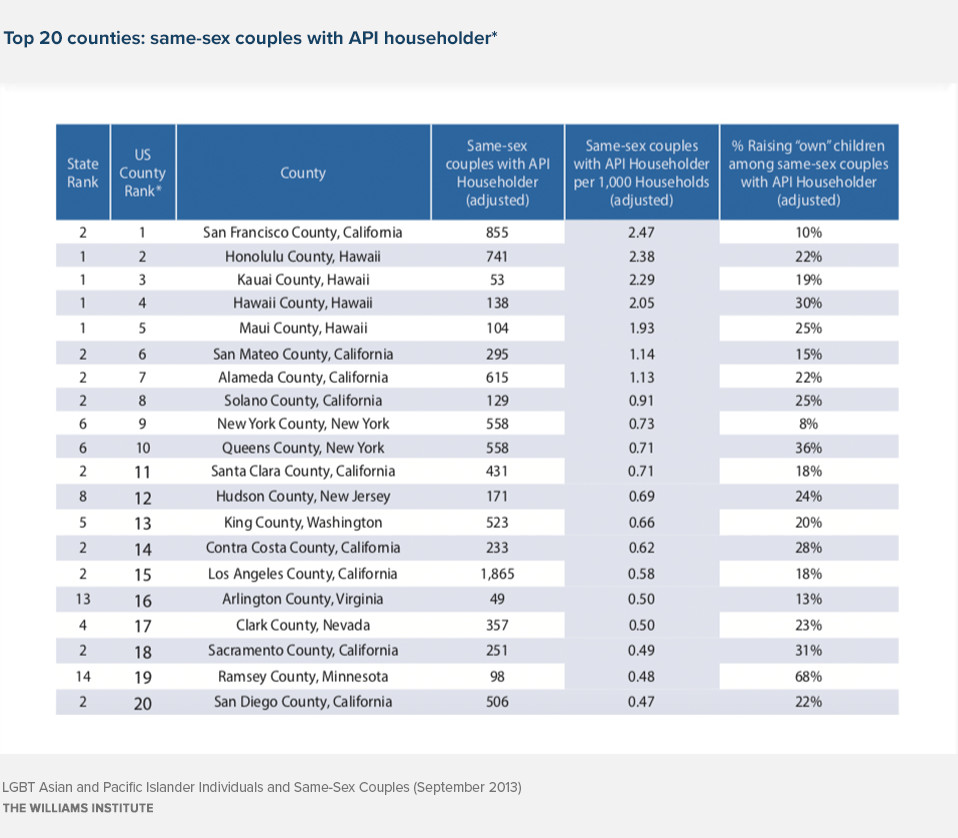
*Including only those counties with 20+ same-sex couples with an API householder
Characteristics of API Individuals
The unit of analysis in this section is the individual. We use Gallup Daily tracking survey data to report on characteristics for those that self-identify as LGBT (both single and coupled). We use ACS data to report on characteristics of individuals in couples. We highlight several characteristics in the charts below, with the additional information listed in Appendix B.
Age Distribution
Direct comparisons between individuals in same-sex couples and all LGBT individuals must be made with caution, as the age distribution of LGBT individuals in the Gallup survey differs from that of API individuals in same-sex couples identified in the ACS. LGBT API individuals are much younger than both the non-LGBT API population and API individuals in same-sex couples. These differences in age could help to explain patterns in other demographic characteristics, like education and employment, that can be affected by age.
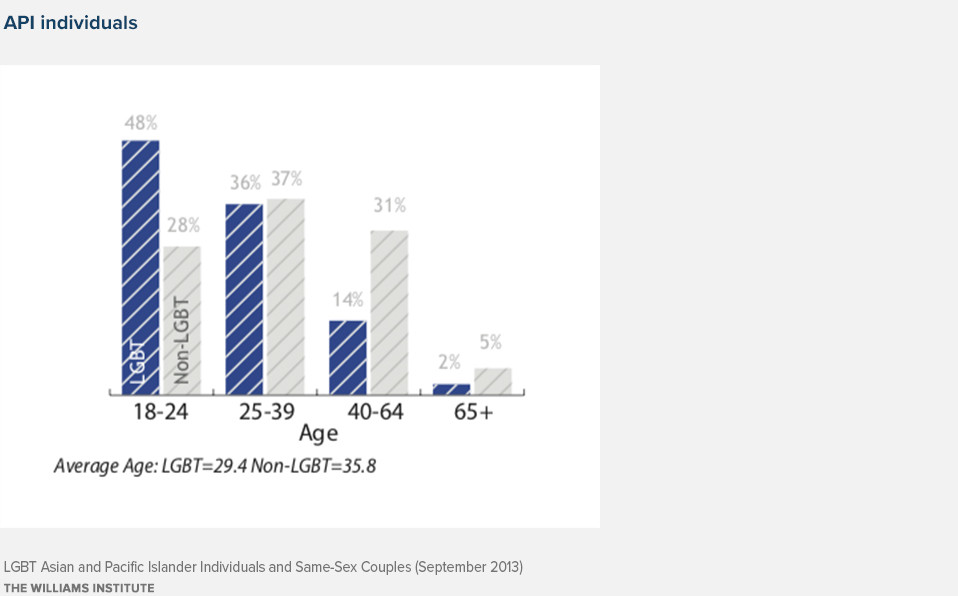
Completed a College Degree or More
API individuals who identify as LGBT in the Gallup survey report lower rates of college completion (42%) when compared to API non-LGBT adults (59%). However, API individuals in same-sex couples have higher rates of educational attainment than their different-sex counterparts (58% vs. 54%). The different results could be in part because LGBT API individuals are much younger than their coupled counterparts.
Employment Status
Unemployment rates are higher for API individuals who identify as LGBT compared to non-LGBT individuals (11% vs. 8%). However, API individuals in same-sex couples are more likely to be employed than their counterparts in different-sex couples (81% vs. 70%). For coupled API adults, the unemployment rate is similar for individuals in same-sex couples and different-sex couples (4%).
Military Status
In general, API men are more likely than women to have served in the military. LGBT API men, both individuals and those in same-sex couples, are less likely than comparable non-LGBT API men to report having performed military service. However, API women in same-sex couples are more likely to report having served in the military than comparable women in different-sex couples. Notably, API women in same-sex couples are five times more likely to enter the military than their different-sex counterparts (5% vs. <1%).
Covered by Health Insurance
Both API LGBT individuals and API individuals in same-sex couples are covered by health insurance at lower rates than their heterosexual counterparts. API LGBT individuals report being uninsured at more than double the rate of API non-LGBT individuals (29% vs. 13%). The gap remains, but shrinks slightly when focusing on coupled API individuals.
Median Individual Income
API individuals in same-sex couples report higher median annual income than those in different-sex couples ($40,300 vs. $30,000). When analyzed by gender, females in same-sex couples report much higher incomes than those in different-sex couples ($37,000 vs. $19,600), while males in same-sex couples report similar incomes compared to those in different-sex couples. We cannot provide comparable data for LGBT individuals from the Gallup survey, as they do not include a question regarding individual income.
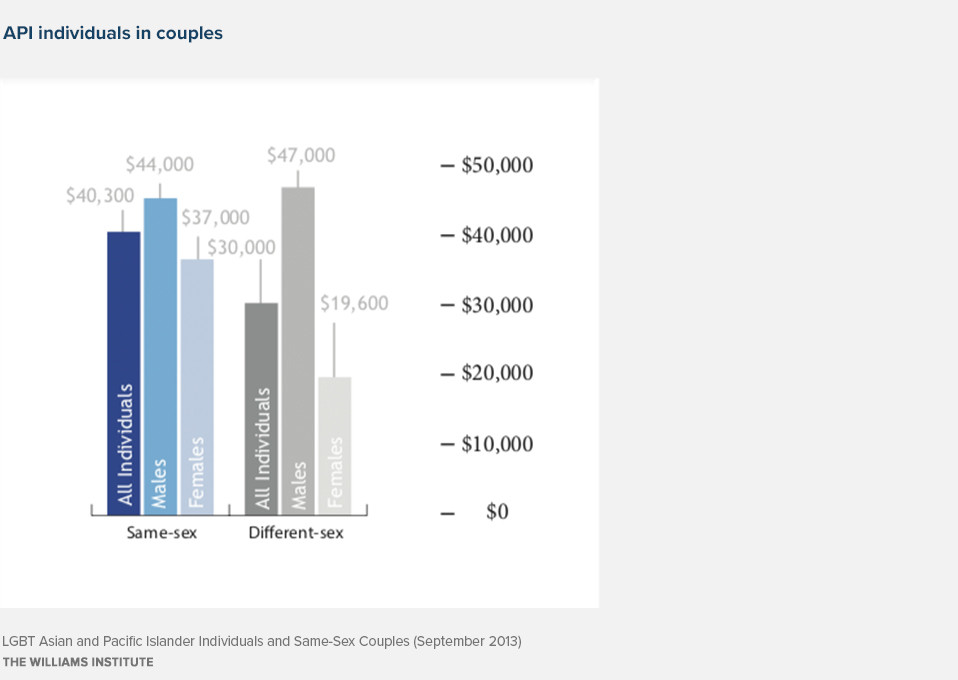
Citizenship Status
Overall, API individuals in same-sex couples are more likely to be citizens by birth than those in different-sex couples (40% vs. 14%). A difference in reported citizenship status between individuals in same-sex couples and different-sex couples can affect proportions of characteristics that may largely depend on citizenship, such as health insurance coverage and income. We cannot provide comparable data for LGBT individuals from the Gallup survey, as they do not include a question regarding citizenship status.

Characteristics of API Couples
In this section of the report, the unit of analysis is the couple. Using the couple as the unit of analysis allows us to view the household as a whole. Below, we present information for both same-sex and different-sex API couples, indicating whether both, one or neither partner has the attribute in question. We also highlight characteristics of those couples that are raising children.
Completed a College Degree or More
Almost three-quarters of all API same-sex couples (72%) include at least one partner with a college degree or more, compared to 65% of different-sex couples. However, the percent of same-sex couples that include two college graduates drops from 42% to 20% when focusing on couples raising children.
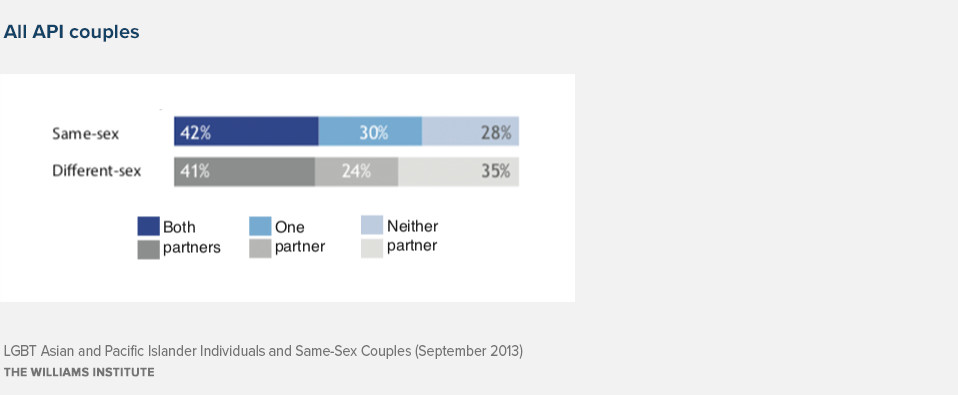
Median Household Income
API same-sex couples report a higher average household income than different-sex couples ($107,000 vs. $85,000). However, gender matters. Female same-sex couples report a mean household income more than $25,000 less than male same-sex couples ($88,500 vs. $115,000). The gap in reported income shrinks when focusing on couples raising children.
Covered by Health Insurance
API same-sex couples are less likely to have health insurance coverage for both partners than different-sex couples (80% vs. 85%). Notably, the gap between same-sex and different-sex couples gets even wider when looking only at couples raising children (69% vs. 86%).
Citizenship Status
Overall, API same-sex couples are more likely than API different-sex couples to have at least one partner with U.S. citizenship status, whether by birth or naturalization (97% vs. 81%). Almost 1 in 5 API same-sex couples have one partner who is a citizen and one partner who reported non-citizen status. Notably, about 1 in 4 API same-sex couples raising children have at least one partner who is not a citizen.
Partnership Patterns
In almost 80% of same-sex couples with an API partner, the other partner is not API. This is the case for only 30% of different-sex couples. Same-sex couples with only one API partner report a higher median household income compared to different-sex couples with one API partner. However, same-sex couples with two API partners make less than comparable different-sex couples ($68,000 vs. $82,800) and are less likely to have both partners complete a college degree than those in different-sex couples (33% vs. 44%).

Country of Birth
API individuals in same-sex couples are much more likely to be born in the United States than API individuals in different-sex couples (35% vs. 13%). Within those born outside of the U.S., the highest proportion of API individuals in same-sex couples are born in the Philippines (17%). For API individuals in different-sex couples, the highest proportion of individuals are born in India (17%). Vietnam, Taiwan and Korea round out the top five list of countries of origin reported by API individuals in same-sex couples.

Subpopulations within API Community
While API same-sex couples appear to be faring well socio-economically, this obscures the needs of subpopulations within the API community. Below, we report on specific characteristics for individuals in same-sex couples and individuals in different-sex couples by race subgroup as defined by the U.S. Census. On the next page, we take a look at reported differences in college completion by ancestry. Compared to similar individuals in different-sex couples, both Asian and Pacific Islander/Native Hawaiian (PI/NH) individuals in same-sex couples report lower rates of health insurance coverage, lower rates of non-citizenship status and higher incomes. However, there are definite reported disparities between Asian and PI/NH individuals. Asian individuals in same-sex couples report more than double the rate of college completion compared to PI/NH individuals, while PI/NH individuals in same-sex couples report more than double the rate of unemployment than Asian individuals.
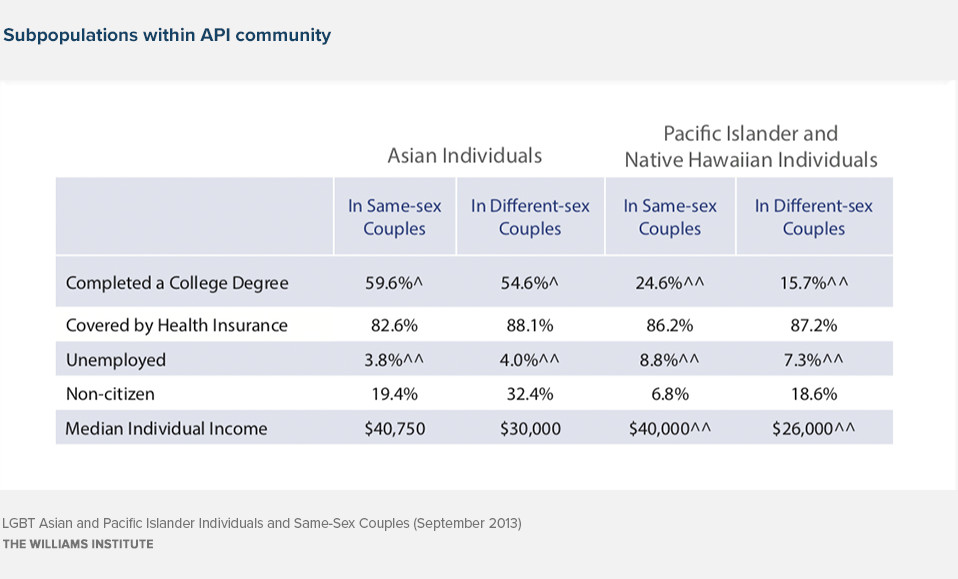
Completed a College Degree or More
College completion rates are often used as a measure of economic well-being. In order to highlight differences in socioeconomic characteristics among subpopulations within the API community, we include college completion rates by ancestry for individuals in same-sex couples and individuals in different-sex couples. For some API subpopulations, the number of respondents in same-sex couples is too low to provide accurate data. In those cases, we include the rates of educational attainment for individuals in different-sex couples as a reference for comparison.
Regardless of ancestry, API individuals in same-sex couples tend to complete a college degree at higher rates than comparable individuals in different-sex couples. However, rates of college completion vary widely depending on individual ancestry. Individuals of Asian Indian, Taiwanese or Pakistani ancestry report high levels of educational attainment, while Laotian, Hmong, Cambodian and Hawaiian individuals report lower rates of college completion.
Further analysis by ancestry is needed to provide accurate information on API individuals in same-sex couples who are often overlooked when looking at the API community as a whole.
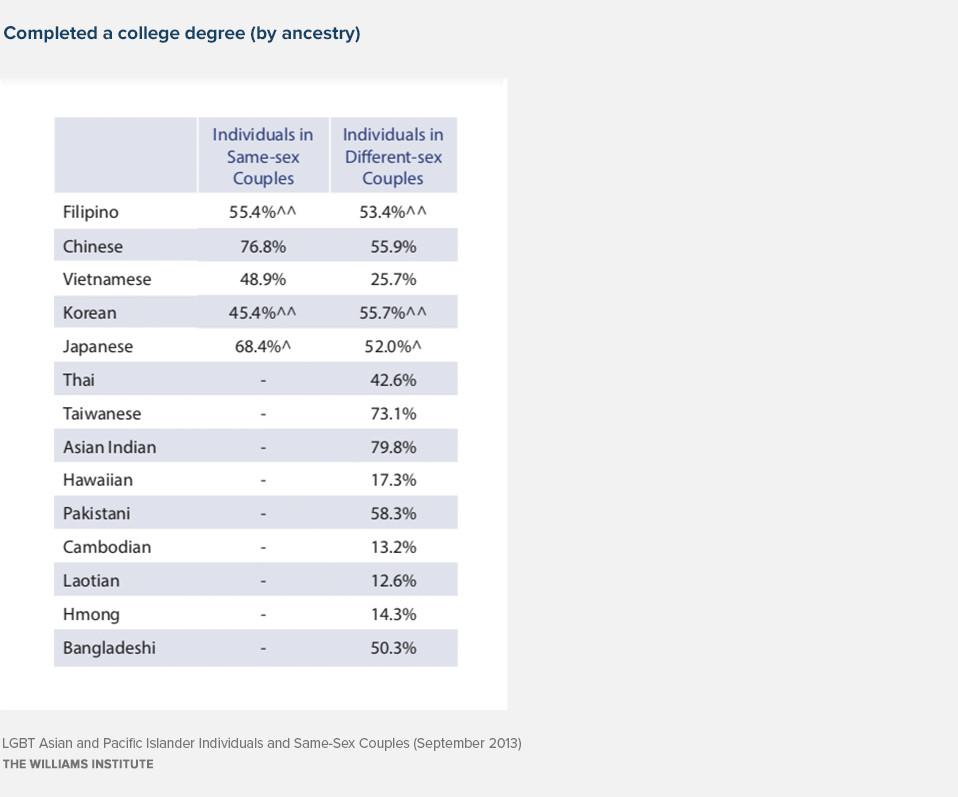
Note: Sample sizes are small when breaking down individuals in same-sex couples by ancestry. Percentages are only reported for groups with more than 30 individuals.
Conclusion
Overall, API individuals in same-sex couples are faring better than their different-sex counterparts. They report higher annual incomes, are more likely to be employed and are more likely to have completed a college degree. However, using the analysis put forth here to generalize for all groups within the API community can result in overlooking key differences within subgroups of the API community. In addition, the gender of a couple and whether a couple is raising children also makes a difference in reported characteristics. API same-sex couples raising children fare worse than comparable different-sex couples in educational attainment and health insurance coverage, while female API same-sex couples report lower annual income than male API same-sex couples. Notably, while API individuals in same-sex couples overall are much more likely to be born in the U.S., API same-sex couples raising children are more likely to have two non-citizen partners compared to API same-sex couples without children. This may have an effect on characteristics such as annual income and health insurance coverage.
Download the brief




